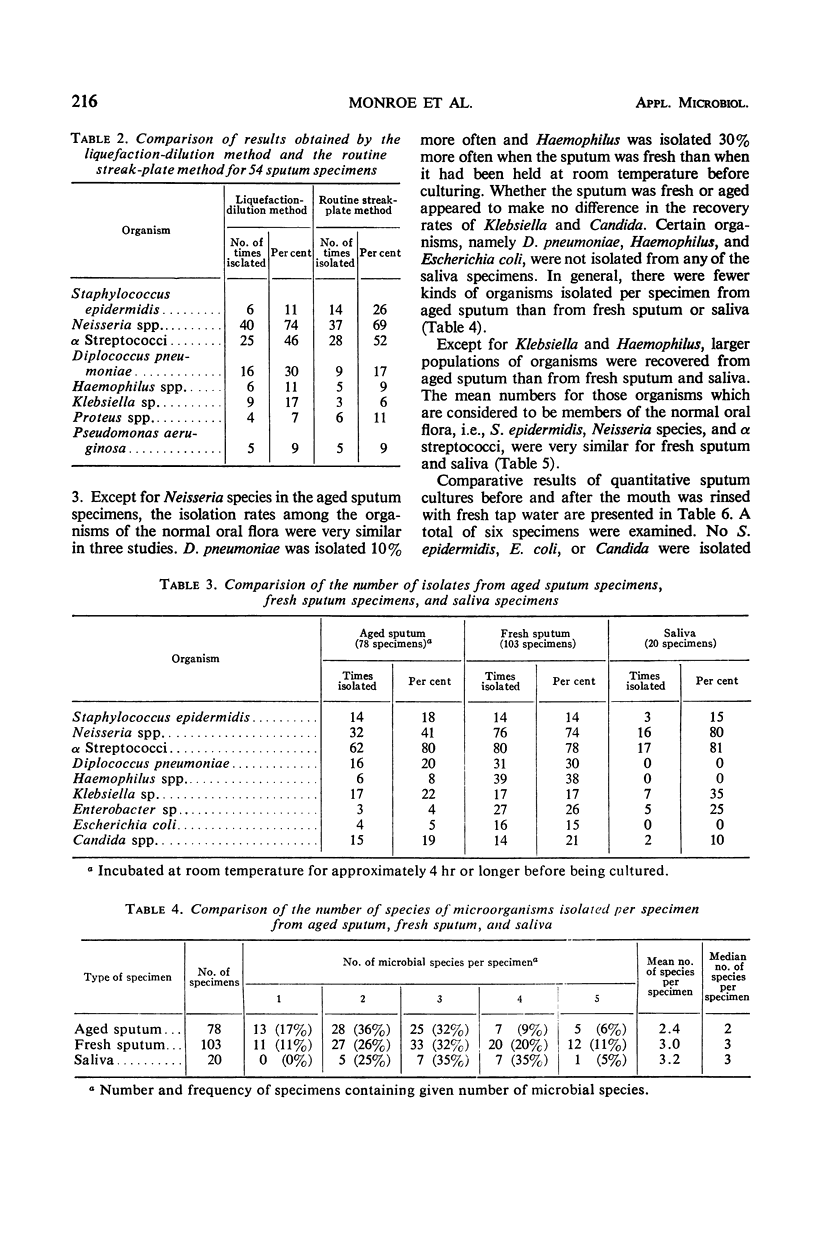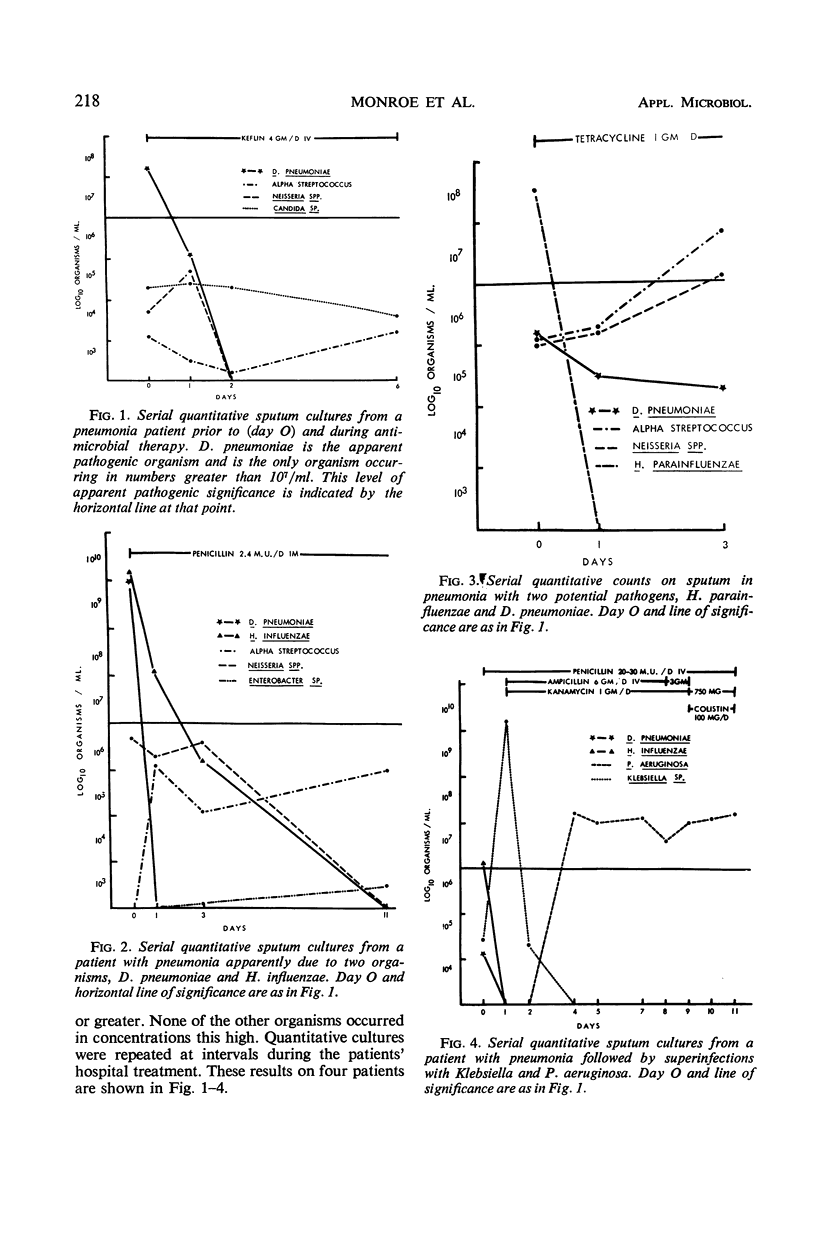Abstract
A method of quantitating microbial cultures of homogenized sputum has been devised. Possible application of this method to the problem of determining the etiologic agent of lower-respiratory-tract infections has been studied to determine its usefulness as a guide in the management of these infections. Specimens were liquefied by using an equal volume of 2% N-acetyl-L-cysteine. The liquefied sputum suspension was serially diluted to 10-1, 10-3, 10-5, and 10-7. These dilutions were plated on appropriate media by using an 0.01-ml calibrated loop; they were incubated and examined by standard diagnostic methods. Quantitation of fresh sputum from patients with pneumonia prior to antimicrobial therapy revealed that probable pathogens were present in populations of 107 organisms/ml or greater. Normal oropharyngeal flora did not occur in these numbers before therapy. Comparison of microbial counts on fresh and aged sputum showed that it is necessary to use only fresh specimens, since multiplication or death alters both quantitative and qualitative findings. Proper collection and quantitative culturing of homogenized sputum provided information more directly applicable to patient management than did qualitative routine methods. Not only was the recognition of the probable pathogenic organism in pneumonia patients improved, but serial quantitative cultures were particularly useful in recognizing the emergence of superinfections and in evaluating the efficacy of antimicrobial therapy.
Full text
PDF






Selected References
These references are in PubMed. This may not be the complete list of references from this article.
- BRUMFITT W., WILLOUGHBY M. L., BROMLEY L. L. An evaluation of sputum examination in chronic bronchitis. Lancet. 1957 Dec 28;273(7009):1306–1309. doi: 10.1016/s0140-6736(57)91637-9. [DOI] [PubMed] [Google Scholar]
- DINEEN P. THE IMPORTANCE OF THE ROUTE OF INFECTION IN EXPERIMENTAL BILIARY TRACT OBSTRUCTION. Surg Gynecol Obstet. 1964 Nov;119:1001–1008. [PubMed] [Google Scholar]
- HOEPRICH P. D. Culture of the urine. J Lab Clin Med. 1960 Dec;56:899–907. [PubMed] [Google Scholar]
- KRAUS F. W., GASTON C. Individual constancy of numbers among the oral flora. J Bacteriol. 1956 Jun;71(6):703–707. doi: 10.1128/jb.71.6.703-707.1956. [DOI] [PMC free article] [PubMed] [Google Scholar]
- LAPINSKI E. M., FLAKAS E. D., TAYLOR B. C. AN EVALUATION OF SOME METHODS FOR CULTURING SPUTUM FROM PATIENTS WITH BRONCHITIS AND EMPHYSEMA. Am Rev Respir Dis. 1964 May;89:760–763. doi: 10.1164/arrd.1964.89.5.760. [DOI] [PubMed] [Google Scholar]
- MAY J. R., DELVES D. M. THE SURVIVAL OF HAEMOPHILUS INFLUENZAE AND PNEUMOCOCCI IN SPECIMENS OF SPUTUM SENT TO THE LABORATORY BY POST. J Clin Pathol. 1964 May;17:254–256. doi: 10.1136/jcp.17.3.254. [DOI] [PMC free article] [PubMed] [Google Scholar]
- Okinaka A. J., Dineen P. Bacterial colony counts on bronchial washings. Ann Surg. 1968 Jan;167(1):47–50. doi: 10.1097/00000658-196801000-00007. [DOI] [PMC free article] [PubMed] [Google Scholar]
- RICHARDSON R. L., JONES M. A bacteriologic census of human saliva. J Dent Res. 1958 Aug;37(4):697–709. doi: 10.1177/00220345580370041701. [DOI] [PubMed] [Google Scholar]
- SANFORD J. P., FAVOUR C. B., MAO F. H., HARRISON J. H. Evaluation of the positive urine culture; an approach to the differentiation of significant bacteria from contaminants. Am J Med. 1956 Jan;20(1):88–93. doi: 10.1016/0002-9343(56)90175-9. [DOI] [PubMed] [Google Scholar]
- SHULMAN J. A., PHILLIPS L. A., PETERSDORF R. G. ERRORS AND HAZARDS IN THE DIAGNOSIS AND TREATMENT OF BACTERIAL PNEUMONIAS. Ann Intern Med. 1965 Jan;62:41–58. doi: 10.7326/0003-4819-62-1-41. [DOI] [PubMed] [Google Scholar]
- WOODHAMS A. W., MEAD G. R. A COMPARISON BETWEEN PANCREATIN AND N-ACETYL-L-CYSTEINE AS SPUTUM LIQUEFYING AGENTS FOR THE CULTURE OF ORGANISMS. Tubercle. 1965 Jun;46:224–226. doi: 10.1016/s0041-3879(65)80067-8. [DOI] [PubMed] [Google Scholar]
- YOUNG G., RESCA H. G., SULLIVAN M. T. The yeasts of the normal mouth and their relation to salivary acidity. J Dent Res. 1951 Jun;30(3):426–430. doi: 10.1177/00220345510300031901. [DOI] [PubMed] [Google Scholar]


